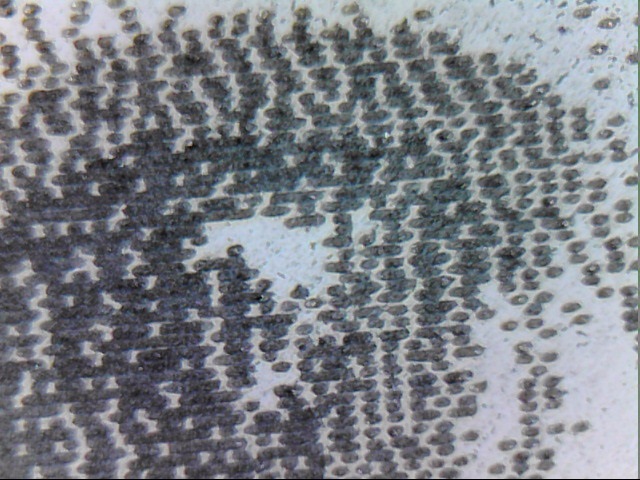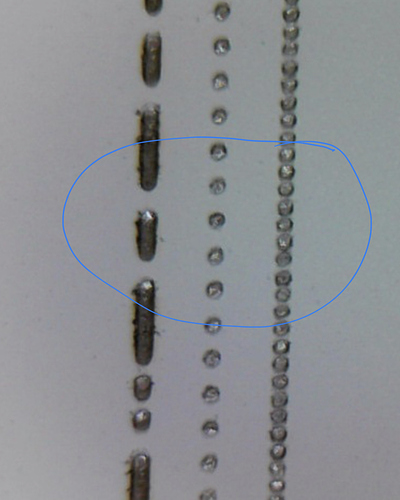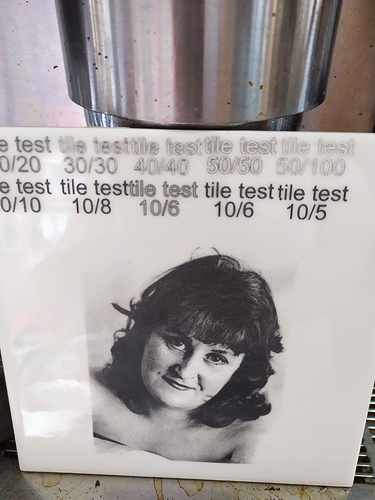How fast and at what power? What wattage tube?
It’s possible that your power is too high and you’re just obliterating the top layer instead of getting the paint to fuse in to the glaze. That happened to me in some of my testing. Low and slow seems to be the way for a CO2 laser.
And here’s a test with the paint that worked. Or seems to. What may look like white/silver in the circles is just reflected light. Circles are as black as the dashed lines in reality.

It’s a 60 watt tube and these tests are run at 20mm/s and 10%.
And here is the test image run at 181 dpi. From the closeup of the highlight of the right eye it looks like the line scan spacing is spot on with no over burn. On second though it looks like maybe I could decrease the scan gap just a hair. This is done with the “dither” setting in LB. I’ve never tried Jarvis. Should I with a photo like this?

Just curious what did you do to obtain this pattern
Is it simple as simple as a line, periods and dashes?
…
—————
Thanx @travisr100
Can’t take credit for that pattern. That’s Russ’ pattern. The bottom/right line is the most useful to me. That’s what lets me estimate dot size. That line is a single row of pixels 10mm long. Each pixel is exactly .1 mm and alternates from black to white. So it’s a .1mm black, square pixel followed by a .1mm white square pixel, and so forth.
If you could fit a dot between every dot you see then you’d have .1mm dots. If the dots are exactly touching but not overlapping then you have .2mm dots. I estimate those dots in the image above at .142 because it appears I can fit 7 of them in 1mm.
You’ll notice that pattern just below the dog in the photo of the tile.
Here’s the actual file of the pattern…
![]()
The patterns in the other lines are useful as well. Russ touches on a lot of uses of this pattern but a lot of it is spread out in multiple videos.
Here’s the video where he initially develops it I believe.
I appreciate your kindness in sharing with me. It means a lot.
Cheers
Sasquatch
Thanks, looks like getting the right “white” paint is also important.
Which paint works better for tile engraving - Acrylic or Acetone based?
A picture is worth a thousand words 
I have plenty of x2 at home as i love those.
Assuming none of these which you have tested are acrylic, have you got any experience with acrylic paints as well?
10x.
Acrylic (water base) won;t work…

Thank you.
hehe, indeed 2X, like Jimmy two times 
Hey Guys I’ve had some reasonable results with Rust-Oleum ultracover primer on CO2 laser(100w) running at 10w (min is about 7w stop firing) and between 5 and 8mm/sec reallllllllll slow take around 4 hours to do a 125x125 tile comes out ok pretty black but impractically slow . I’m pretty certain the frequency 10.5um isn’t good for fusing the paint to the glaze your better off with a low power mini fibre laser Blue, I’ve seen it work on a youtube vid with as little a 3w and only take an hour and much better contrast.
Would you mind posting a photo of your end result? I’m very curious to see your outcome.
Cheers ![]()
Sasquatch
Or run at 5x or 10x the speed at a higher power?
Light pressure/time
Hi I tried higher power and speed but it didn’t seem to work very well see Pic’s . The first pic took over 4 hours an came out with scan lines through it not sure why its only bad in some spots, it might have been my spraying job on the tile to begin with. The second pic has the testing at the top the numbers are Power(watts)/Speed mm/s the picture below the tests came out quite nice.




